Heli-Max EC 145
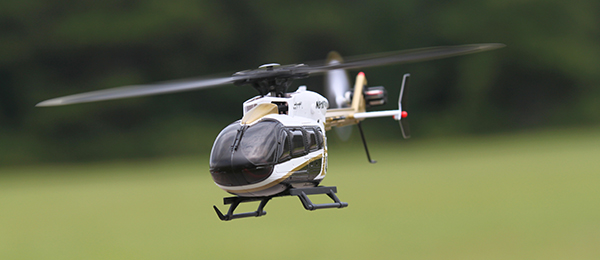
1/43 Scale Collective Pitch Helicopter. Bonus photos and review by Andrew Griffith. A condensed review by Andrew Griffith appears in the December 2013 issue.
Background
The Eurocopter EC145 is a twin-engine, jet-turbine-powered helicopter that can accommodate as many as nine passengers and two crew members in a cabin that would make a luxury car owner jealous. Designed for executive transport, the EC145 is a true multirole helicopter that has found a home in civil aviation, law enforcement, and even military applications (designated UH-72). The high stance of the main blades and tail rotor, combined with the rear cabin clam-shell doors, makes the EC145 well-suited for medical evacuation. The generous ground clearance allows crew members to load patients with the engines idling and the blades still turning, minimizing on-scene time. The roomy cabin accommodates two stretchers side-by-side and allows the medical crew room to work. A fast cruise speed of 135 knots helps accident victims receive lifesaving treatment at a trauma center during that all-important initial hour.First Impressions
3-D pod-and-boom-style helicopters are great, but break out a Scale helicopter and everyone stops what they are doing and watches. Recent breakthroughs in stabilization technology such as the Triple Axis Gyro System (TAGS) have opened up a new world of possibilities for miniature helicopters. This is particularly true for Scale helicopters such as the recently released Heli-Max UH-60 Black Hawk and the subject of this review, the civilian Eurocopter EC145. I unpacked the Heli-Max EC145, organized the contents of the box, and looked everything over. The EC145 is loaded with attractive details such as panel lines, windshield wipers, radio navigation antennas, and hundreds of simulated rivets. The four-blade collective-pitch rotor head is controlled by a 120° swashplate driven by three digital microservos. A 14,750 Kv electric brushless motor and speed controller supply ample power to the main rotor.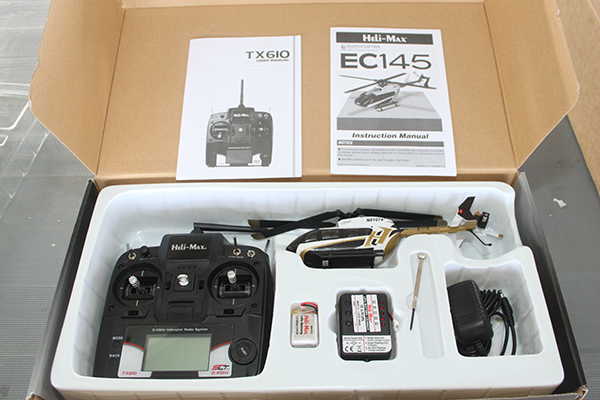 The Heli-Max EC145 kit contents.
The Heli-Max EC145 kit contents.
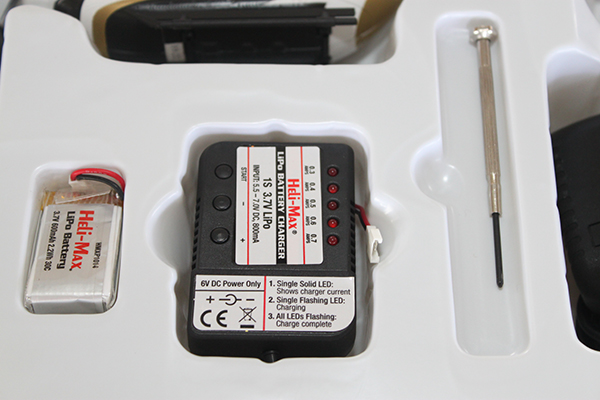 The variable-rate charger and 600 mAh, single-cell LiPo.
The variable-rate charger and 600 mAh, single-cell LiPo.
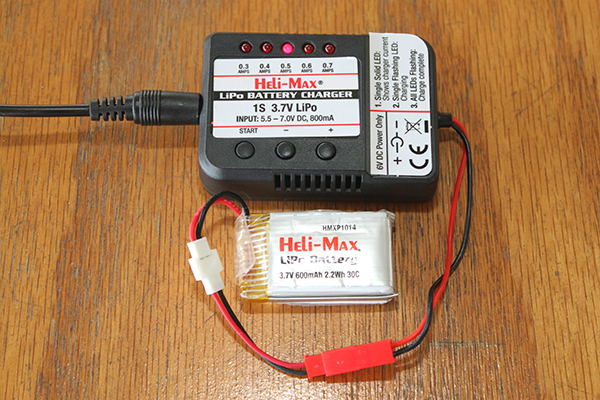 The variable-rate charger and 600 mAh, single-cell LiPo.
The variable-rate charger and 600 mAh, single-cell LiPo.
Anti-torque duties are provided by a separate tail motor with a fixed-pitch tail rotor. Although this may not have the same precision as the torque-tube-driven Black Hawk, the separate motor means power is not being robbed from the main rotor to drive the tail, and it will be easier to fix if repairs are necessary. The front doors, windshield, and the forward portion of the doghouse comprise a sliding hatch used to access the battery and electronic components. The canopy is held in place by two small, powerful magnets and is easily removed for battery access. I set the model aside and examined the Heli-Max TX610’s transmitter. I’ve been underwhelmed by many of the radios that accompany other RTF models, so the Heli-Max TX610 was a pleasant surprise. Similar to many radios, it is 2.4 GHz, but the difference is that this is actually a usable six-channel computer radio system that has a 10-model memory and accommodates helicopters and airplanes. When you compare the pricing between the Transmitter-Ready (Tx-R) and RTF versions of the EC145, you realize that you’re getting a computer radio with pitch and throttle curve, programmable exponential and dual rates, remote gyro gain, and buddy-box capability for a $50 price difference! The TX610 features a 21/2 x 13/8-inch LCD display and the menus are accessed by two buttons and a scroll wheel reminiscent of several Futaba radio models. Rounding out the contents of the box are a 600 mAh, single-cell LiPo battery, a variable-rate battery charger, and two instruction manuals. One 15-page printed manual covers the TX610 and another 20-page booklet is for the helicopter. Also included are a small Phillips screwdriver and a spare tail rotor blade. The screwdriver is used to change the blades or disassemble the model if repairs are necessary. There are no adjustments on the TAGS board.
Construction
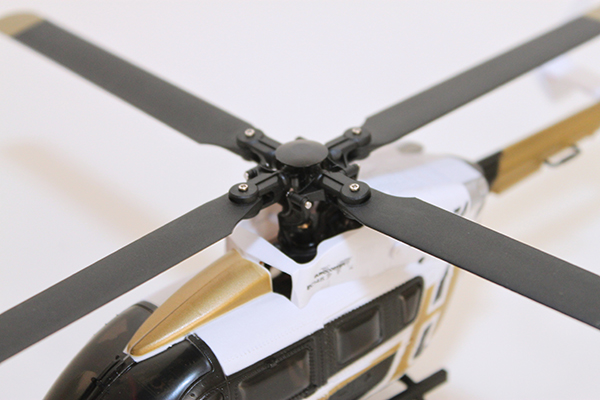 The scale, four-blade rotor head with collective pitch allows for spirited performance.
The scale, four-blade rotor head with collective pitch allows for spirited performance.
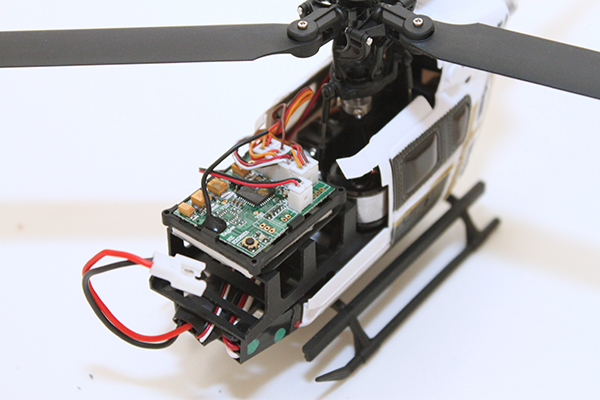 The TAGS gyro board and battery shelf.
The TAGS gyro board and battery shelf.
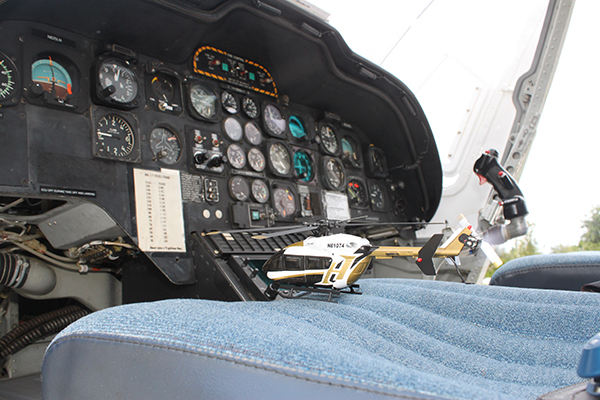 The tail rotor is a separate motor with fixed pitch.
The tail rotor is a separate motor with fixed pitch.
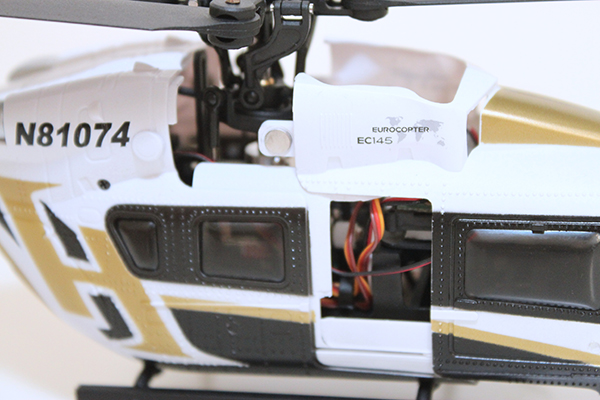 Small magnets hold the canopy in place and allow easy access to the battery. The rivet details and Eurocopter logo are fantastic scale touches on such a small model.
Small magnets hold the canopy in place and allow easy access to the battery. The rivet details and Eurocopter logo are fantastic scale touches on such a small model.
The included battery charger plugs into a standard 110-volt outlet. It’s simple to use—plug the charger in, plug the battery in, and set the charge current with the plus and minus buttons. When you have .6 amps selected for the included 600 mAh battery, press charge and wait for the charger to beep, telling you the charging is complete and you’re ready to fly. Batteries are less than $10, so stocking up on a couple of spare batteries isn’t an expensive proposition. When the battery is charged, turn the radio on, flip on the throttle hold, slide off the canopy, and insert and connect the battery while keeping the helicopter flat and still so the TAGS system can initialize. Slide the canopy back into place and you’re ready to fly.
Flying Indoors
Heli-Max lists three skill levels on its website: Easy, Intermediate, and Expert. Because the EC145 is listed in the Expert category, you should have already logged plenty of flight time with easier coaxial and fixed-pitch helicopters before attempting to take on the collective-pitch EC145. Before venturing outdoors, I wanted to try the EC145 indoors to see how it handled with no wind. High rates inside my moderate-size living room were slightly alarming. The low rates that came preprogrammed in the six-channel radio were spirited. I landed and, thanks to the computer radio, added some exponential to each cyclic axis and reduced the low rates by 10 points. This made the EC145 more manageable and I was able to hover around the living room and easily take off and land on my coffee table. Although I have reviewed many smaller helicopters, most of my flight time is with 50-size nitro and 600-size electric helicopters. When I fly a smaller electric helicopter, it takes me time to get used to the responsiveness. One issue that I have often encountered with micro-size helicopters is the lack of a solid feel in the tail gyro. There is no problem with that on this model. The EC145 is solid with the gains provided from the factory, and I experienced no perceptible drift or tail wagging. I was soon flying transport missions between the coffee table in the living room and the dining room table and back. The only one not impressed was the cat, who suddenly took up residence in another part of the house.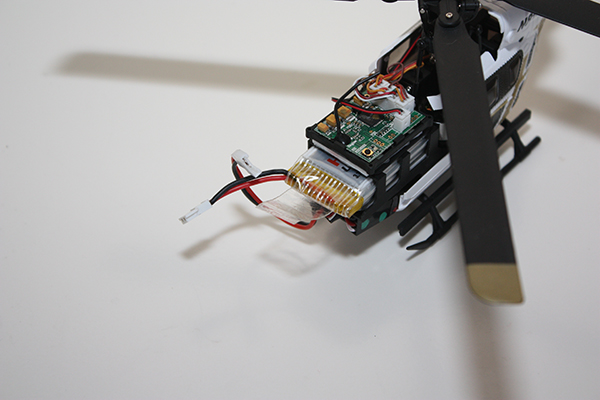 Easy access allows the battery to be changed. Note the clear pull tab provided on the battery for easy removal.
Easy access allows the battery to be changed. Note the clear pull tab provided on the battery for easy removal.
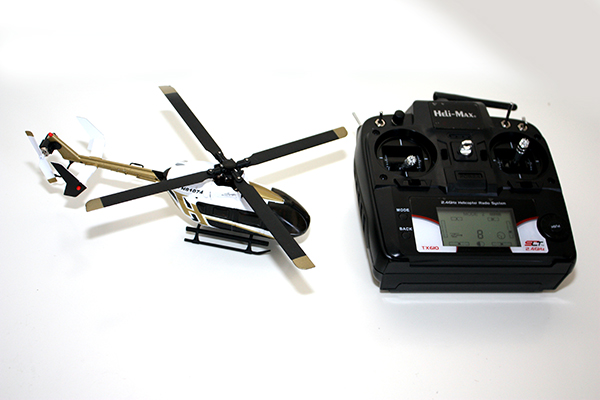 Compare the size of the EC145 model with the provided six-channel computer radio.
Compare the size of the EC145 model with the provided six-channel computer radio.
Flying Outdoors
After I had flown a few battery packs inside and attained a high comfort level flying the EC145, I installed a fresh battery pack and headed outside. I selected high rates on the radio, took off, and flipped the EC145 into idle-up mode. The TAGS-equipped helicopter handled the light, but variable, 3-5 mph winds well. One thing that surprised me about the EC145 was that it will fly fast! I’ve never been a fan of flying Scale helicopters upside down, but the EC145 is collective pitch, capable of aerobatics, and will loop, roll, and stall turn. Fixed-pitch tail rotors generally don’t do well in fast backwards flight. If you try to get going backwards too, the EC145’s tail will whip around, which is to be expected. The only issue I had flying the EC145 outside is that the black and gold finish, combined with the small size, made it hard to determine orientation depending on the background or if it was farther away. I had the EC145 out at our local flying field; Anthony Lively and Ray Lovell flew it for me while I was shooting pictures. It was fairly breezy, but the helicopter handled the wind well. They both had problems keeping it still in the wind, though, which is not unusual for such a lightweight helicopter.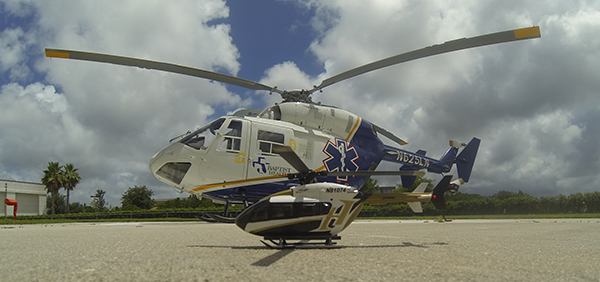 The EC145 visits its full-scale Life Flight counterpart at the Baptist Medical Center in Jacksonville FL.
The EC145 visits its full-scale Life Flight counterpart at the Baptist Medical Center in Jacksonville FL.
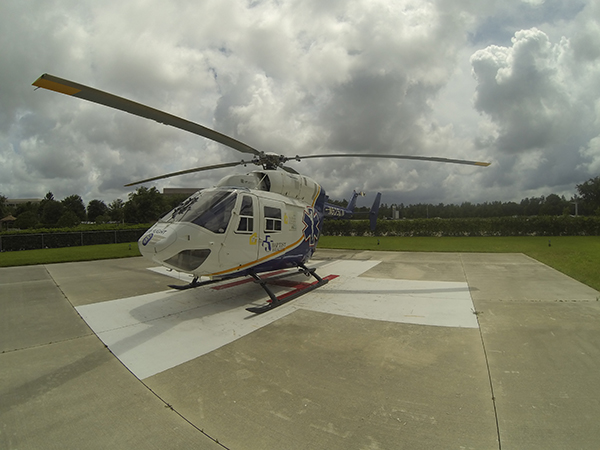
Conclusion
The Heli-Max EC145 is a gorgeous helicopter that replicates many of the details of its full-scale counterpart. TAGS allows models such as the EC145 to have a great scalelike and functional four-blade rotor head that would have been unheard of a few years ago. Although not for beginners, it flies well and can handle mild winds if flown outdoors. If the wind picks up, take it inside. It can be flown in nearly any living room or garage because of its small size. The low weight and low inertia also mean little damage if you crash. The inclusion of a six-channel computer radio with adjustable rates, exponential throws, and curves makes the EC145 a value that is hard to pass up. It also makes taming the helicopter to suit a pilot’s preferences easy, which is rare in a model of this size and price. It’s inexpensive, flies great, and looks fantastic. What’s not to love? I’d like to thank the Baptist Medical Center and the Jacksonville Life Flight team in Jacksonville, Florida, especially Chief Pilot Jim McCoy, for taking an interest in my project and allowing me to photograph the model with its big brother.Specifications
Model type: Collective-pitch RTF electric helicopter Skill level: Intermediate to advanced Rotor span: 9.6 inches (245mm) Length: 12 inches (305mm) Weight: 3 ounces (85 grams) Power system: 14,750 Kv brushless motor and ESC; receiver; and digital servos Street price: $199.99Test-Model Details
Motor used: 14,750 Kv brushless motor Battery: 3.7-volt, 600 mAh LiPo Rotor blades: 4 x 105mm Radio system: Tactic TX610 computer radio (included with RTF version) Ready-to-fly weight: 3 ounces Flight duration: 4 minutesPluses
• TAGS gyro system makes for a stable helicopter. • Great-looking scale outline and details. • A+ battery access facilitated by magnetically secured forward cabin. • RTF version comes with a surprisingly flexible computer radio.Minuses
• Plastic is delicate. My model had a chipped vertical fin out of the box.Manufacturer/Distributor
Hobbico 3002 N. Apollo Dr., Ste. 1 Champaign IL 61822 (800) 637-7660 www.helimax-rc.comMore Bonus Photos
Bonus Product Description
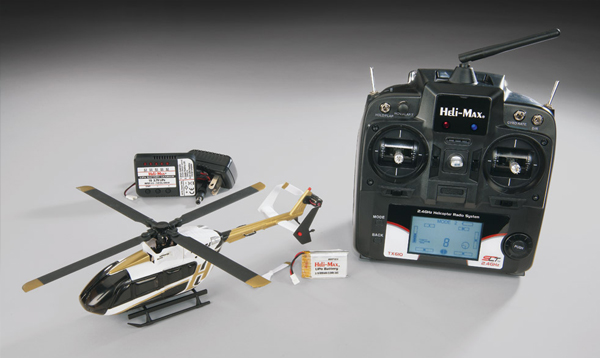
The beauty of Tx-R technology is that you can use the transmitter that's already set up just the way you like it to fly virtually any Tx-R model. The twin-engine Eurocopter EC145 has served in a variety of roles, including emergency medical service and search-and-rescue efforts, but is perhaps best utilized as a corporate transport aircraft. Heli-Max has replicated the EC145 in a 1/43 scale electric model with extensive scale detail that you have to see up close to believe. The injection-molded body alone includes rivets, windows, turbine exhausts, tie downs, door outlines and more. One look at this exceptional machine will have you wanting to fly it — and its smooth, stable performance will have you flying with confidence. Both the RTF and Tx-R versions come with a LiPo flight battery and charger, so you're just minutes away from piloting this well-appointed machine!
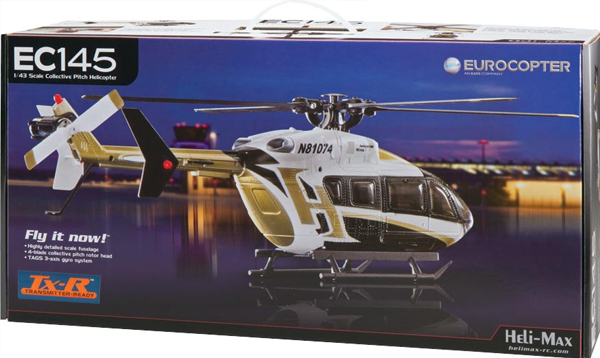
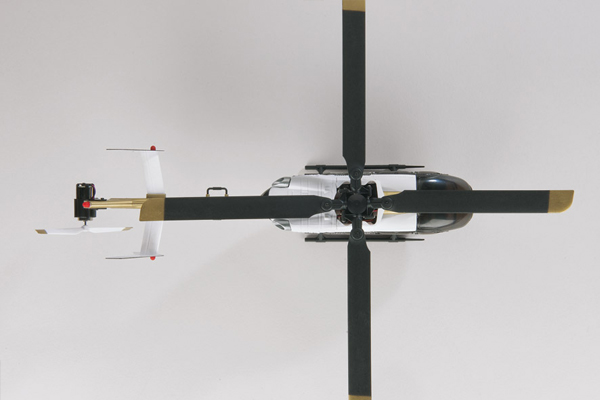
The unique 4-blade rotor head features collective pitch that expands the heli's maneuverability — while the TAGS 3-axis gyro provides smooth, stable flight. TAGS goes far beyond a single-axis gyro, giving stability to the yaw, roll and pitch axes. That means you can fly your EC145 with confidence, knowing that external forces will not adversely affect its performance. It's stability taken to the next level — once you've experience TAGS, you won't ever want to fly without it! All bonus photos and text from www.HeliMax-rc.com.
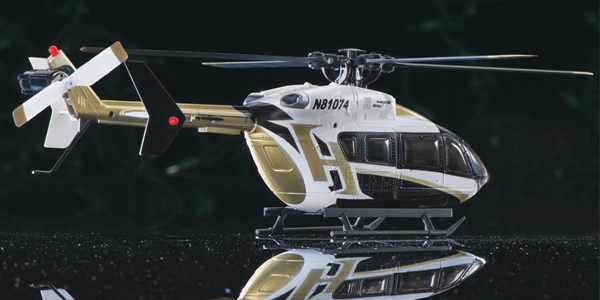
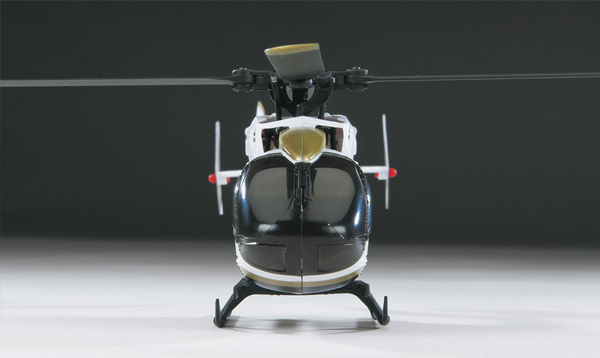










1 comments
Helimax radio system included in this package. Helimax Eurocoper
Add new comment